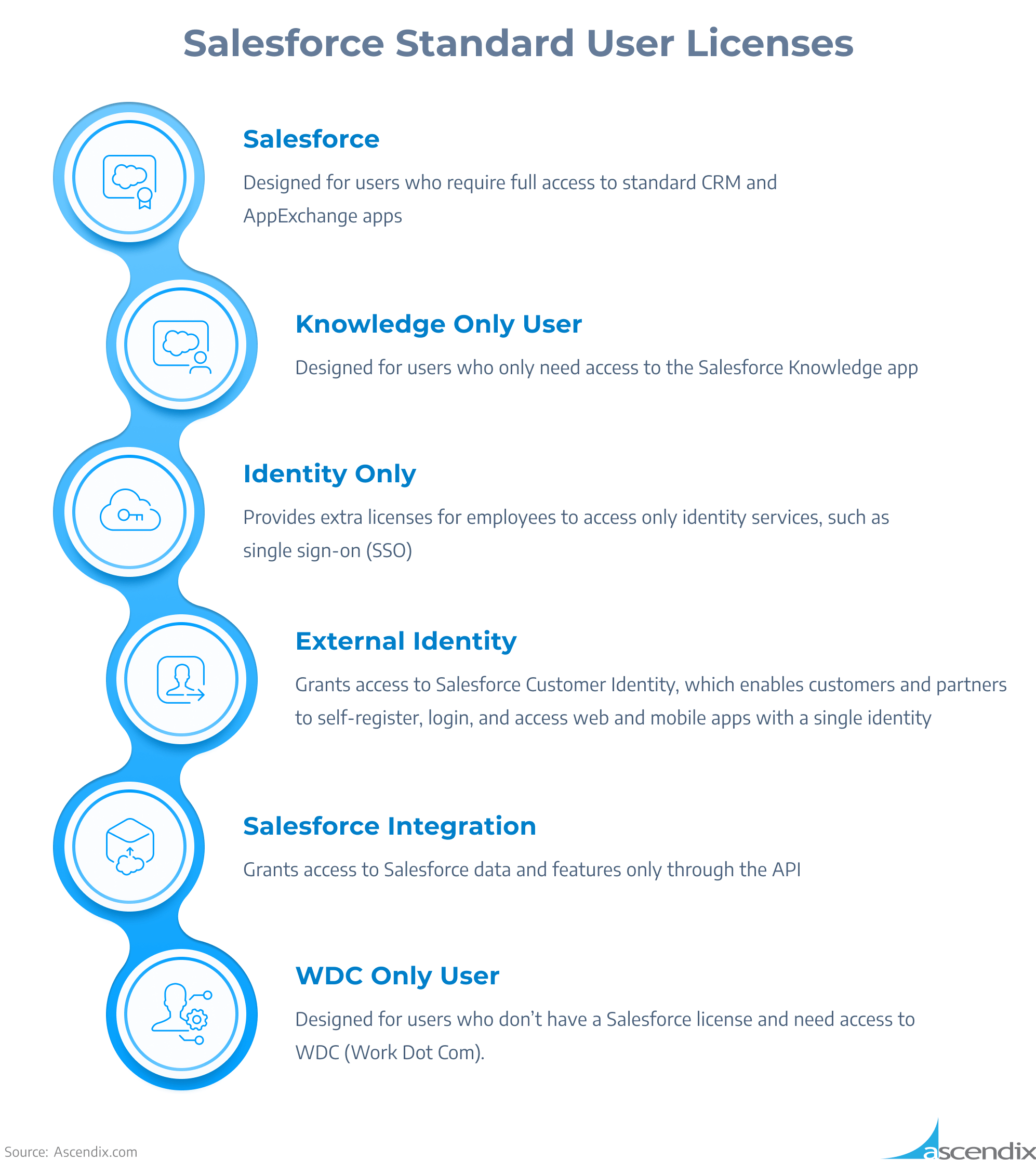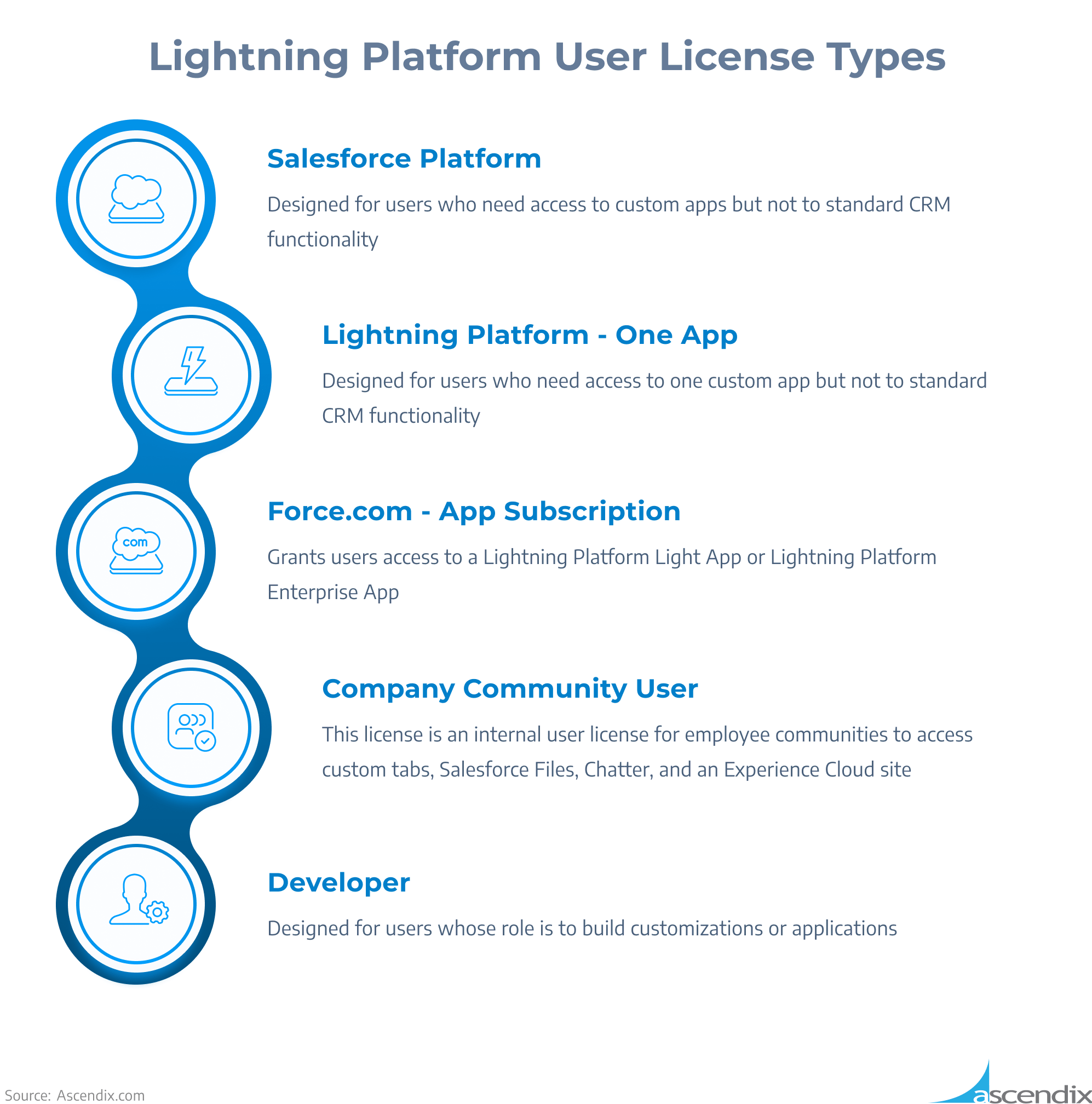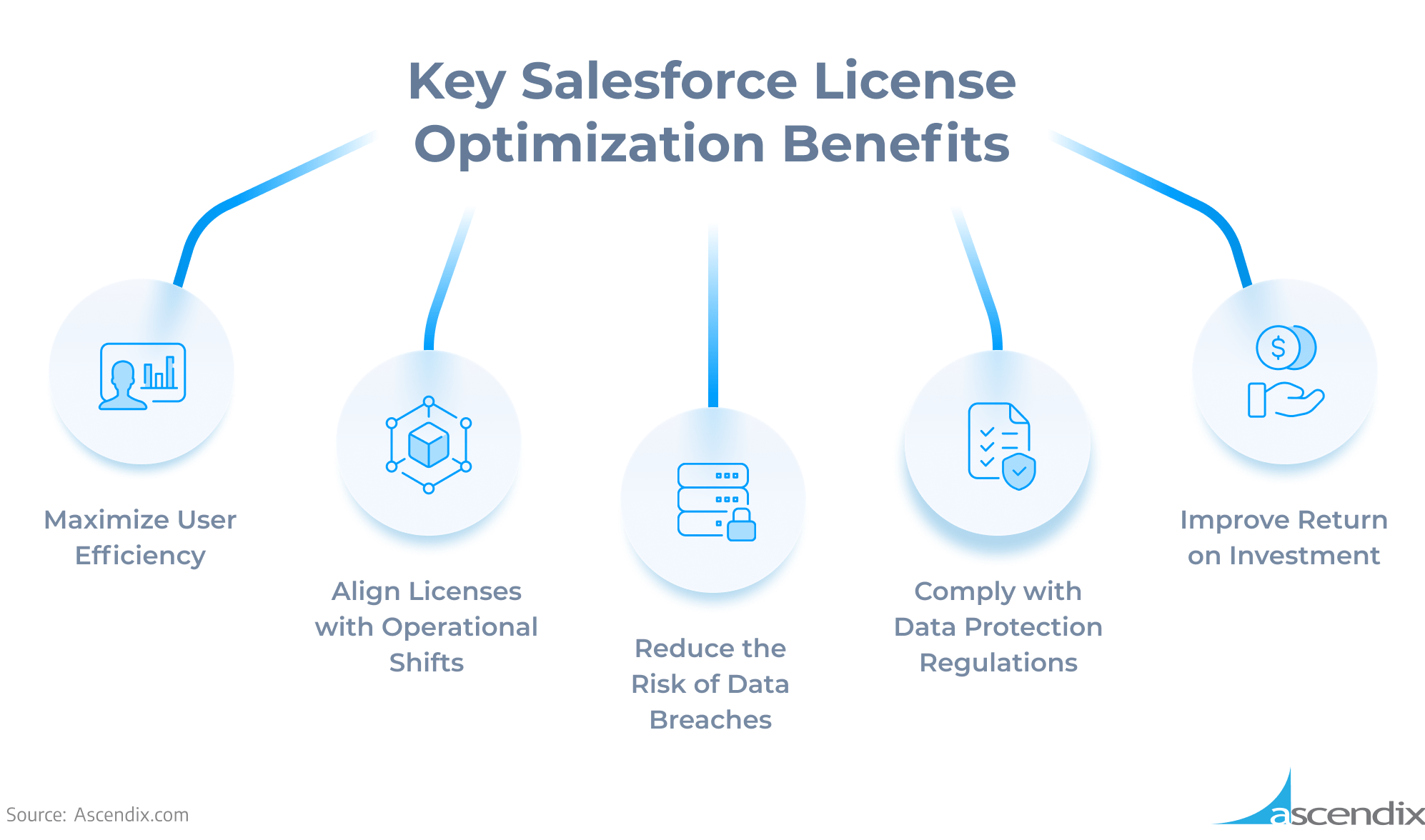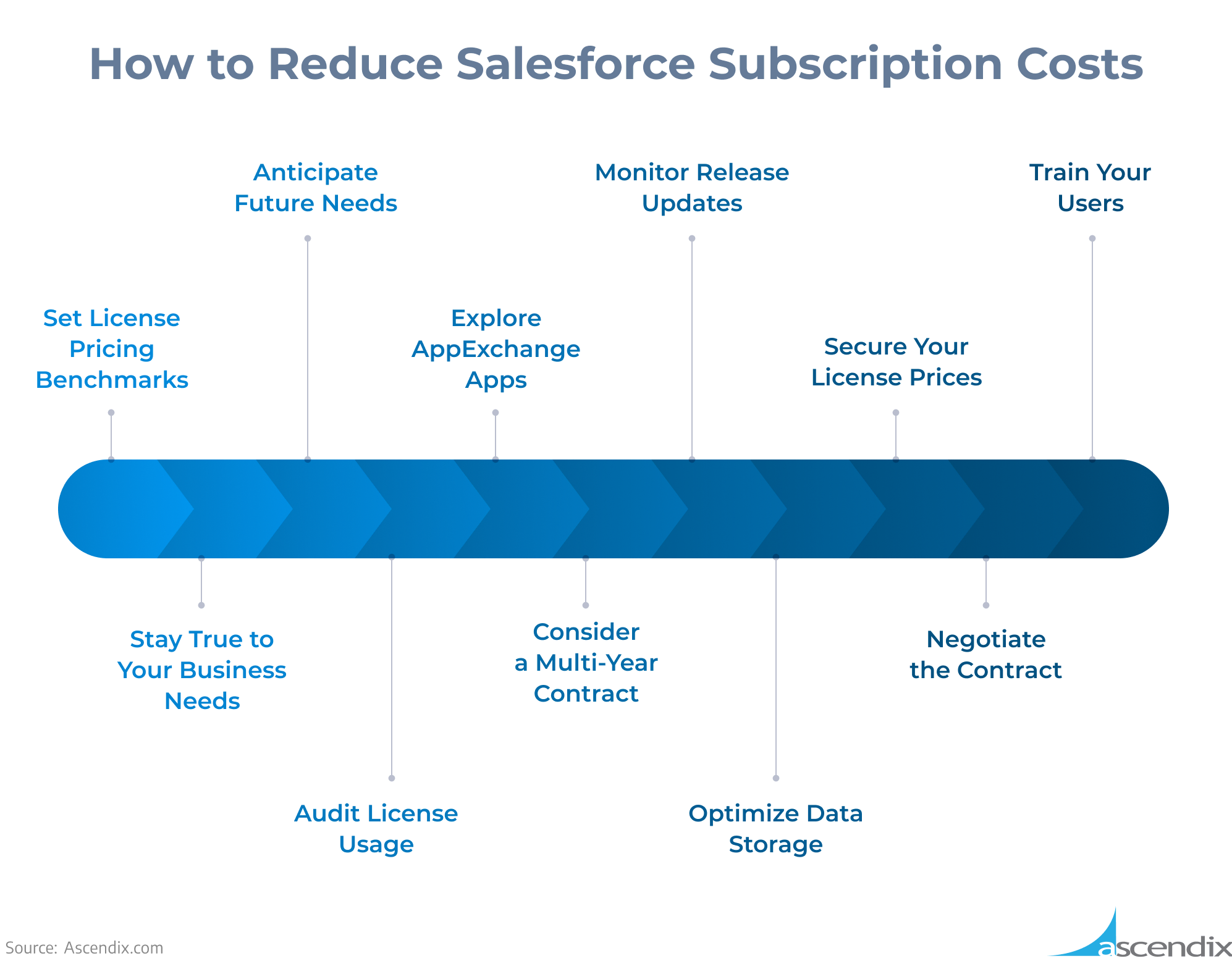Need Help with Salesforce License Optimization?
We will help you assess your platform usage and ensure that you use your licenses in the most optimal way.
Salesforce licenses can represent a significant expense for organizations, particularly when there’s a need for multiple or specialized licenses. Salesforce license optimization strategies help avoid purchasing excess licenses, reduce Salesforce licensing costs by retaining unused ones, and get the most out of your Salesforce investment.
So, if you want to fuel customer satisfaction and give your business a high-tech upgrade with Salesforce, but also save extra money on future innovations, this blog post is for you.
In this article, we’ll cover aspects of:
The average cost of Salesforce implementation is well explained in our blog post “Real Cost of Salesforce Implementation”. As a short recap, to calculate the total Salesforce cost you need to consider:
The list can go on, so being proactive in uncovering potential hidden costs for a precise Salesforce budget as well as engaging with Salesforce directly or consulting a Salesforce partner will help you calculate Salesforce cost.
Remember, Salesforce, like other SaaS companies, may adopt a ‘land and expand’ strategy, offering enticingly low initial rates that could surge by 20% upon renewal.
Furthermore, don’t overlook cost-influencing factors like data storage and API Call limits that you may reach sooner than expected. Limited functionality available in the standard Salesforce mobile app might also necessitate the purchase of Salesforce Mobile App Plus, adding an extra $25 user/month.
To avoid the risks of running an over-priced solution, you need to deploy a Salesforce license optimization strategy and negotiate your contract rates. But first, let’s uncover the Salesforce license cost structure.
Salesforce licenses and their implementation cost are the key points that make businesses ask questions like: is this reasonable pricing I am quoted? Effective Salesforce license management is one of the most effective ways to optimize your CRM investment.
That’s why we should add some context to Salesforce licenses first. Salesforce has three primary pricing models for its products:
Salesforce licenses grant users access to specific products and features within your company’s Salesforce platform. These licenses, assigned individually, determine a user’s base access level, which is then fine-tuned via profiles, permission sets, and role hierarchy.
Licenses have different permission and preference settings which also influence the Salesforce license pricing structure.
Permission set licenses and preference set licenses can be bundled into licenses that define functionality for the whole org or individual users (user licenses).
To get a more accurate Salesforce cost estimation, you need to understand various standard Salesforce license types and how they can be used. Further, these licenses can be combined within one organization to cut costs.
Salesforce User Licenses set the fundamental access to features for a user, with each user limited to one type, such as Salesforce, Platform, or Identity license.
On the other hand, Salesforce Feature Licenses offer access to extra features beyond the base edition, and multiple such licenses can be assigned to users. Examples include Flow User, Knowledge User, and Service Cloud User.
As a Salesforce customer, you can mix and match different license types within a single organization. Salesforce editions usually have several types of licenses.
For example, if you purchase the Sales Cloud Enterprise Edition, you get a Full CRM user license and a Chatter Free license.

Salesforce Standard User Licenses | Ascendix
Most popular Salesforce products: Sales Cloud and Service Cloud are offered in four editions: Growth, Professional, Enterprise, and Unlimited. Salesforce edition pricing ranges from $25 to $330 per user per month.
Also, products like Sales and Service Cloud can be bundled together for cost compression or extended with add-on products.
Find out more about Salesforce Marketing Cloud or Pardot editions pricing
A Salesforce Integration User License is another cost-saving option designed for system-to-system integrations. This type of license doesn’t fit for users needing Salesforce data or feature access via a user interface.
Integration User Licenses can revolutionize your Salesforce setup by reallocating integration-specific tasks from standard licenses to API-only access ones.
This not only frees up valuable licenses for users but also offers a more cost-effective way to manage integration access. The result is a more efficient, budget-friendly Salesforce environment.
Moreover, Salesforce provides five complimentary Integration User Licenses for Enterprise organizations. Should you need more, additional licenses can be conveniently acquired at a nominal fee of $10 per user per month each.
Consider using the Identity Only sub-license of Salesforce license when your employees require access solely to identity services such as single sign-on (SSO). With this type of license your organization can control your users’ access to Salesforce data and applications.
These licenses enable businesses to create and manage users, define their permissions, and authenticate them across different applications. For instance, some of your employees might not need full Salesforce functionality but may benefit from direct SSO access to a custom web app from your Salesforce org. To check this license pricing, it’s better to contact Salesforce directly.
By combining full Salesforce licenses, Salesforce Platform licenses, Salesforce user licenses, and appropriate login licenses, businesses can efficiently utilize the platform while reducing expenses.

Lightning Platform User License Types | Ascendix
You can also use Salesforce Platform licenses where applicable. They are available on Enterprise and Unlimited editions and provide full access to all custom apps in the organization as well as to core functionalities like:
However, it’s lacking some of the standard CRM functionality like:
The Salesforce Platform pricing has two versions: Platform Starter for $25 user/ month and Platform Plus for $100 user/month .
The key difference between these two plans is that with Salesforce Platform Starter you’ll get access to 10 custom objects and with Platform Plus – to 110.
These licenses can be a cost-effective option for users who don’t need full CRM functionality.
While the Enterprise license can cost you around $3,000 USD per user per year, a Platform license can cost as low as $300 per user per year. This means that your organization can save $2,700 per user annually.
An under-the-radar opportunity for cost reduction is the utilization of login licenses, specifically designed for Experience Cloud users. Comparable to purchasing mobile phone minutes, they can be bought as needed.
Login licenses fall under Customer Community licenses and are tailored for external users requiring occasional access to the community but not to the internal org and cost $2/login per month. For Partner Relationship Management, a portal license will cost $10/ login per month.
We will help you assess your platform usage and ensure that you use your licenses in the most optimal way.
Salesforce license optimization is a practice of ensuring your organization is using the most cost-effective Salesforce licenses which align with your business needs. It usually involves understanding different user requirements and license types, regular license usage audits, effective management of unused licenses, and, of course, contract negotiation.
Research by Gartner says organizations can cut software costs by an impressive 30 % with the right license optimization strategy.

Key Salesforce License Optimization Benefits | Ascendix
With Salesforce license optimization efforts, you can maximize efficiency and help your users perform their job more effectively by assigning them the right license with all the necessary Salesforce functionality. Also, regular optimization aligns Salesforce licenses with operational shifts meaning when users change roles, you may change in time the type of license and access to it.
In addition, certain licenses grant access to sensitive data and administrative features. By ensuring users only have access to the data and features they need, you can reduce the risk of data breaches and comply with various data protection regulations.
However, to ensure that your organization is healthy and fully compliant with Salesforce security standards, you need to perform regular system security audits. You can find out more about our Salesforce security assessment best practices in our blog post.
So, Salesforce license optimization is not just a cost-saving exercise but a strategic necessity for efficient operations, better security, and improved return on investment.
Check our post about Salesforce Experience Cloud and details on what you can build with it
Trimming annual rates stands as a formidable challenge for Salesforce customers, primarily due to its contract terms designed to commit customers to fixed annual costs and 100% of license volume renewal for negotiated terms to be valid.

How to Reduce Salesforce Subscription Costs | Ascendix
The good news is that it is not the only option. You can reduce Salesforce licensing cost and you can effectively rationalize it by following these steps:
If you only plan to subscribe to Salesforce CRM, you need to set realistic pricing expectations which should consider your company size, the size of your average deals, your industry, and estimated budget limits.
You also need to understand what different users need from Salesforce and what data they use to select the best license types and their numbers. It will be a good starting point to negotiate your license cost.
If you need to have a more precise estimation, you can refer to Salesforce consultants, who will evaluate your business specifics, how much you really need to pay for your type of project, and help you successfully negotiate the prices.
Although attractive product bundles like Customer 360 may entice you, it’s crucial to begin with what you really require now. You should tailor your solutions and editions to your immediate needs and remember that there’s always room for future growth, upgrades, and renegotiations. The key is to stay flexible and not be afraid to discuss better terms and license reduction when the time is right.
Even though predicting the scale of software requirements as a business evolves can be challenging, businesses must do it while buying software. Underestimating future requirements can lead to costly last-minute purchases or upgrades, while overestimating could result in a surplus of unused, and therefore wasted licenses.
It’s important to regularly review license usage to identify areas for potential savings. This might involve using:
These will provide more detailed insights into your Salesforce under/unutilized licenses and recycle them accordingly. Also, some users might not be using all the features their license provides, while others might require additional capabilities. Ask people to justify why they need the license (if typically, they don’t need it) before giving them access.
Perform a system audit for anyone who hasn’t logged in for 45-60 days, so you can reassign licenses as needed to maintain efficiency and pay for features you really use. Also, you can check your user list and deactivate any users who no longer use Salesforce. This can free up licenses for other users and help you avoid purchasing unnecessary ones.
Organize your data based on community type, license type, and frequency of logins, and determine where you can opt for cheaper licenses if some users don’t need access to the entire CRM.
Another good option is to inspect if you can use community licenses, connectors, or AppExchange solutions instead of full licenses.
To reduce Salesforce-related costs without compromising on the utility of the Salesforce platform license you can consider long-term contracts to benefit from lower per-user license costs. Long-term contracts provide reassurance that Salesforce will continue to be part of your operations for the foreseeable future and reduce Salesforce licensing cost.
Keep your finger on the pulse of the latest release updates and license changes and don’t miss out on leveraging new, advantageous features. Stay informed and agile to optimize your costs, reallocate licenses, and make the most of each Salesforce enhancement for your business advantage.
While Salesforce charges additionally for data storage, efficiently managing your data and file storage can also reduce costs. Regularly clean up and archive old or unnecessary data to avoid exceeding your data storage limits and incurring costs. If you need more guidance on the data storage optimization process, get help from professional Salesforce consultants like Ascendix.
Don’t let your pursuit of the lowest upfront price eclipse the bigger picture – securing favorable Salesforce licensing pricing for a long time. Remember to strategize for the future, ensuring cost-effectiveness and pricing predictability upon renewal.
Engage in discussions to trim down the Salesforce licensing cost at renewal time. When the moment arrives to renew your Salesforce contract, arm yourself with the powerful insights derived from your license optimization efforts.
Ensure you’ve negotiated a strict cap on any renewal increase to shield from larger-than-anticipated hikes at renewal. Also, negotiating the price of your Salesforce add-ons can be a treasure trove of savings which can considerably reduce your total Salesforce expenditure.
Remember, you’re not just renegotiating a contract – you’re championing the financial efficiency and strategic agility of your business.
To ensure that your users take full advantage of Salesforce’s features, your cost optimization strategy should involve user training. Video tutorials, guides, and workshops will help you work with the platform proficiently, thus reducing dependence on additional licenses.
We will teach you how to use CRM software to the fullest without overpaying for unnecessary functionality.
If you are looking to cut your Salesforce costs, consider renegotiating your contract upon renewal, particularly if you hold more than 100 licenses. Your Salesforce account executive could offer up a license reduction, a 10% discount, or even 25% for contracts worth several hundred thousand dollars.
Such deals incentivize Salesforce AEs with the promise of consistent commissions. However, bear in mind that bargaining for lower license costs might entail certain risks.
In the realm of Salesforce agreements, decommissioning or eliminating products doesn’t necessarily equate to a cost reduction. This essentially means that while you might cease utilizing certain resources, your current environment’s costs might not be subject to a corresponding decrease.
Traditionally, the norm for renewal caps hovers around the seven percent mark. However, there’s a growing trend towards the concept of one-time pricing within Salesforce forms. In essence, this allows Salesforce to increase contract prices substantially during renewal periods.
Negotiating restricted-use licenses with Salesforce can be a cost-saving maneuver. It’s ideal for users needing partial functionalities and don’t want to pay the full license cost. But there’s a catch – Salesforce doesn’t disable unused functionalities.
If users exceed their agreed usage, you may face additional charges for contractual breaches and may end up paying the difference between full enterprise license costs per usage and the prevailing rate of restricted-use licenses.
So, if you choose to negotiate discounts and opt for this type of license cost optimization, you should be aware that you need to constantly monitor restricted-use license utilization to avoid exceeding negotiated limits and applying fees. Or delegate this task to professionals like Ascendix who’ll ensure that you use your licenses in the most optimal way.
Salesforce offers opportunities to swap unused products for those more suited to your needs. It also accommodates transferring products between different departments within your organization. However, there might be restrictions attached. Grasping the implications of these limitations for your business is an essential part of the negotiation process.
Start by collecting usage data from your organization and reviewing the products you’ve already rolled out. Next, anticipate any upcoming needs for license expansion. Draw up two distinct lists: one for beneficial extras, and another for smart future investments. Integrate these into your demand model, helping you stay organized. This three-year-ahead strategy is a smart way to plan, ensuring you’re ready for whatever comes next.
Kickstart your negotiation journey by crafting a well-planned calendar. From your initial Salesforce interaction to presenting your proposal, ensure you hold the reigns of the timeline. Kick-off negotiations 8-10 months ahead of your current license expiration.
After wrapping up discussions, delineate various scenarios to either broaden or curtail your planned agreement. This will be based on your must-have elements and wishlist items. Explore alternative timelines for software deployment tailored to your company’s unique requirements.
Refrain from sharing project start dates until negotiations commence. Let your IT team initiate informal talks with Salesforce, indicating your needs subtly without forming any contractual obligations.
Ensuring better licensing coordination enables license acquisitions, and disposals to be more efficient and understand which licenses can be repurposed for use in a better way,
If you want to have the right licensing structure which meets your budget, hire Ascendix, a certified Salesforce consultant, to optimize your Salesforce license cost and usage. As an expert with a 20+ year track record, we know the best practices on how to improve your Salesforce license usage.
Together we’ll ensure your organization is making the most of its Salesforce investment by combining cost-saving measures with strategies to improve its efficiency and productivity.
Besides that, our agency will help you:
If you are lost in Salesforce license types and editions, have questions about the calculation of real Salesforce subscription costs, or need help with understanding Salesforce cost structure, get your free consultation today!
Salesforce offers multiple packages tailored for small businesses. The Essentials plan, starting at $25/user/month, provides core CRM functions. For advanced features, the Professional and Salesforce Enterprise editions begin at $80 and $165/user/month respectively. Prices vary depending on user count and bespoke business requirements.
Salesforce’s cost varies based on the chosen plan and user count. The Sales Cloud Essentials plan starts at $25/user/month, providing basic CRM functions. The Professional and Salesforce Enterprise edition plans, offering more advanced features, start at $80 and $165/user/month respectively. Custom needs and user quantity ultimately determine the exact cost.
The annual cost of Salesforce depends on the chosen plan and user count. Basic CRM features via the Essentials plan start at $300/user/year. More advanced Professional and Enterprise plans begin at $960 and $1,980/user/year respectively. The final cost is driven by specific needs and the number of users.
Anzhelika is a seasoned B2B content marketing strategist with extensive experience in elevating corporate profiles through compelling content. At Ascendix, she offers a wealth of knowledge in Salesforce consulting, providing valuable tips, tricks, and comprehensive guides. Additionally, Anzhelika stays at the forefront of the industry, delivering expert analysis on the latest Salesforce tools and emerging technology trends.
Follow us and get expert insights and guides right to your inbox.